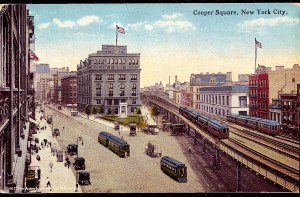One Hundred Twenty Five Years of NYC Streetcars Started in the Village
New York City Trolley or Streetcar service ended in New York City on April 6th, 1957 on Welfare (now Roosevelt) Island. But it began one hundred twenty five years earlier on November 14, 1832, with not only New York City but the world’s first streetcar line which ran on the Bowery and Fourth Avenue, between Prince and 14th Street.

Trolleys were an effective way to travel for decades and directly related to where development occurred in the growing city. An improvement over horse drawn carriages, their predecessor, they dominated our streets until cars, buses and the subway system edged them off the platform of transportation options.
Always looking for a faster way to get around town, and adapt to different real estate and development dynamics, public transportation has changed quite a bit since the city’s first efforts in the 1820’s. Crowded subways with people sandwiched next to each other coupled with intense car and truck traffic are leading to new ideas inspired by history for getting around town and changing the minds of naysayers.
Mass transit emerged in NYC with the “horse bus” or “Omnibus” in the late 1820’s as the city’s first mode of mass land transportation. An over-sized stagecoach of sorts pulled along by horses could accommodate a dozen or so people and regularly ran up and down Broadway. When people who were riding wanted to get off, they pulled on a little leather strap that was connected to the ankle of the driver!

Horse drawn transport continued, but the next step in the evolution was to install embedded iron or steel tracks, designed to carry more people and offer a smoother ride than before. The horse-drawn streetcar debuted in 1832 along Fourth Avenue and the Bowery in Manhattan. Running from the Lower East Side to Union Square, it was opened by a company called the New York and Harlem Railroad, which had ambitions (eventually realized) of connecting New York (today’s Lower Manhattan) with suburban Harlem. That first streetcar was called the John Mason, named for the President of Chemical Bank and one of the wealthiest New Yorkers, who was also a co-founder of the railroad company. Believe it or not, this humble but groundbreaking (literally, as the tracks were embedded in the ground) transportation line is the direct forefather of today’s Metro-North Railway system which carries millions of passengers each years from Grand Central north not just to Harlem but the Bronx, Connecticut, Westchester, and Upstate New York.

Health concerns about horses following the Equine Influenza outbreak of 1872, the slowness of horse carriages, and new technology led to more innovative developments.
In 1883 New York City’s first steam-driven Cable Car emerged, which ran until 1909 when electric trolleys hit the urban scene of all five boroughs. The basbeall team in Brooklyn was so-named because of the enthusiastic fans that had to “dodge” the traffic en route to the stadium (in fact, the team’s original name was “The Brooklyn Trolley Dodgers,” which was later shortened).
The electric streetcar system might have survived the competition of the marketplace because of it’s comparable efficiency for intracity movement. But the automobile industry did not want competitive forms of travel. From the 1920’s to the 1950’s automobile interests bought streetcar systems and worked to substitute rubber-tire vehicles for trolleys.

But you can’t bury the trolley tracks entirely. Today new considerations of urban design and planning that seek to exploit, honor or unearth this history are emerging in NYC.
Mayor Deblasio has proposed a $2.5 Billion trolley in Brooklyn and Queens that could potentially lead to great changes in land value and use.
Closer to home, the Village Crosstown Trolley Coalition, a group of neighborhood residents, have long had a proposal to restore the river-to-river streetcar line that once existed along the 8th Street Corridor.

Also in the works is the proposal for an underground park in Manhattan known as the Lowline. The location was used until 1948 as a station and balloon loop for trolleys.

One incarnation of the trolley in NYC certainly ended in 1957. Next stop, no one knows.

When were steam dummies used for streetcars in New York? I know there was a cablecar over the Brooklyn Bridge from 1883 until? But what about steam dummies?
Thank you for enjoying our blog. According to https://www.nycsubway.org/wiki/Fifty_Years_of_Rapid_Transit_(1918) “In the year 1870, when the first dummy engine trains ran on the first elevated railroad…”.
I have read extensively about the mode of transportations in the past and how it has evolved. This blog was quite enriching. Horse carriages remain a significant landmark in transportion and were used for a long time. Today very rarely places still use horse carriages as a genuine mode of transportation, otherwise it’s a mere thing of enjoyment or novelty.
do you know their hours of operation? How late into the night did the trolleys run?
I was born in Brooklyn in the 1940s I rememberthe Utica Avenue Trolley car in front of my home
Brooklyn’s last trolley was on Church Avenue. Service ended on October 31, 1956.